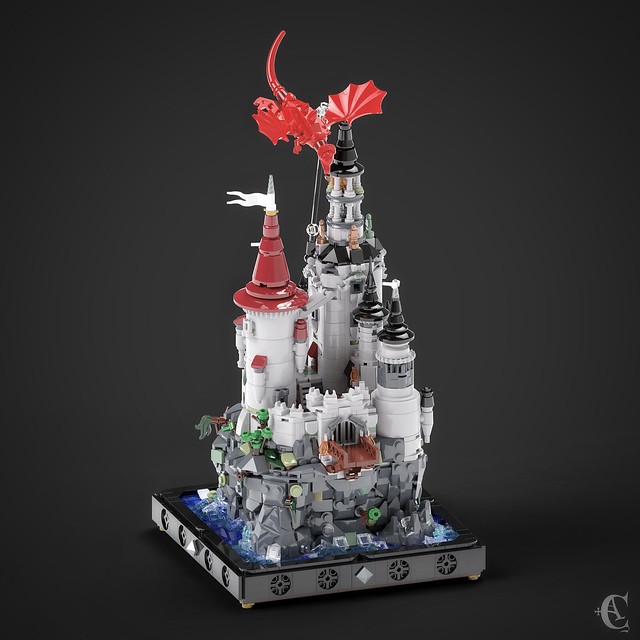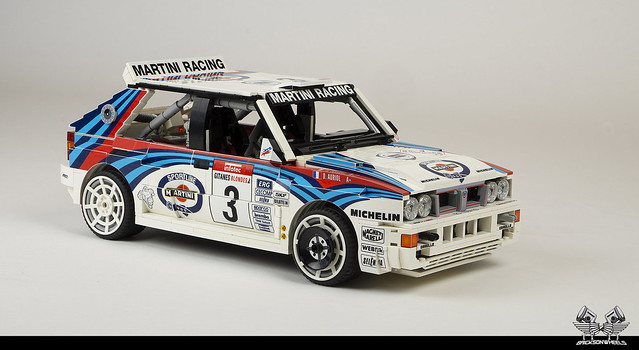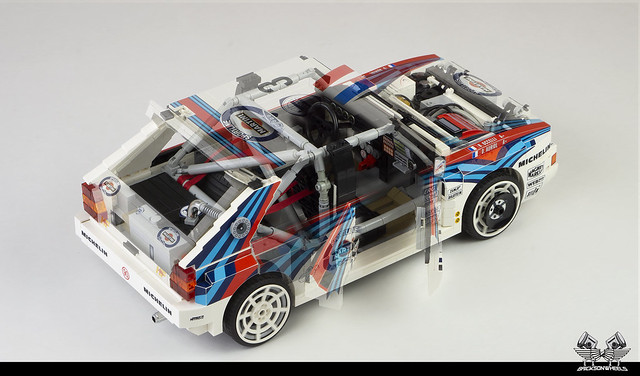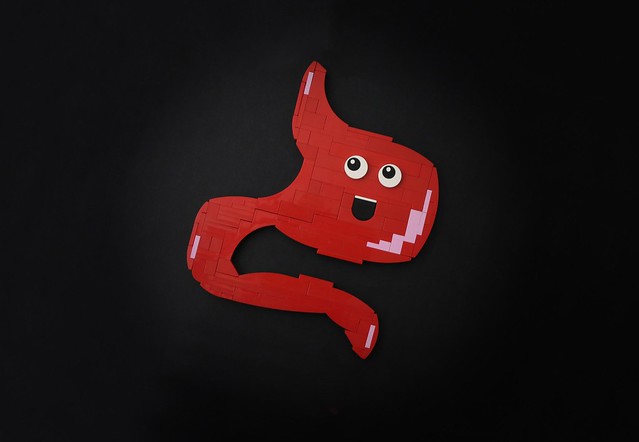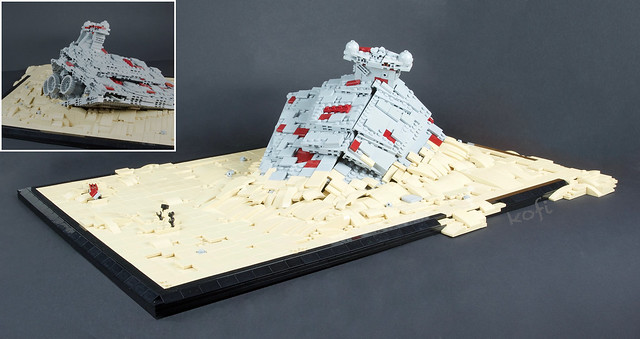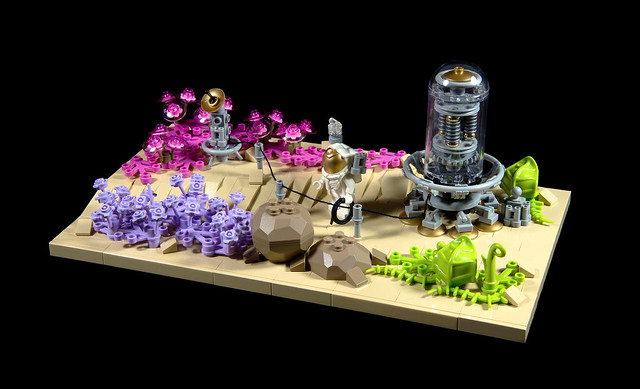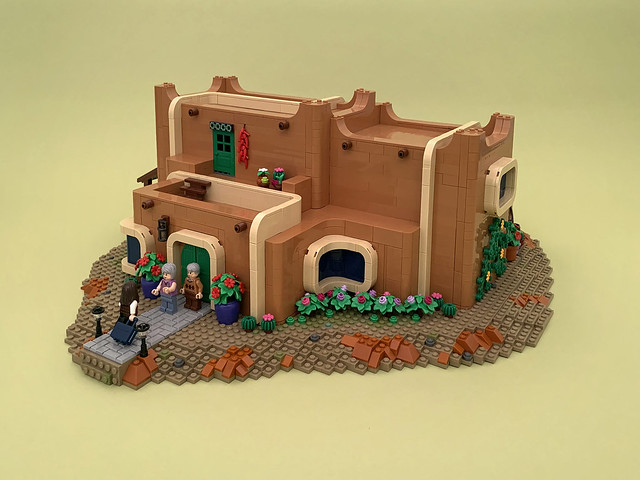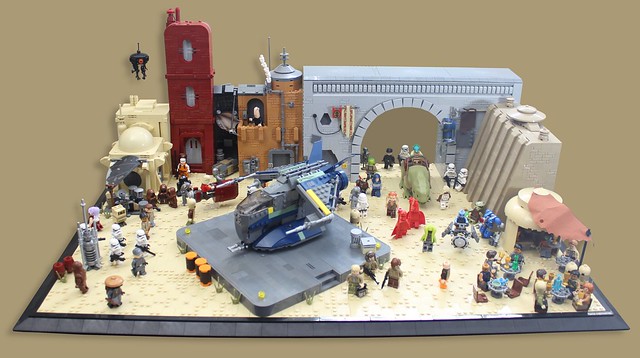Never underestimate the power of a good color scheme. This gorgeous orange, teal, and white racer by Chris Perron is instantly eye-catching thanks to its bold shades. The car isn’t just all flash, though, as it’s designed as a futuristic mag-lev vehicle around a large rear ball, held in place with a pair of orange basketball hoops. The ball originally hails from Duplo, and it’s one of only a few elements to have successfully made the jump from Duplo to System sets. The use of 3×3 radar dish pairs for front “wheels” also works great (do mag-lev cars need wheels?).
Posts by Chris
Get all your LEGO Klämtares at this tiny IKEA
Need more Klämtares, Kuggises, or Ivars for your LEGO collection? Look no further than IKEA, now in minature form thanks to cubo31. IKEA announced a new partnership with LEGO last year, and we still haven’t seen many details on what that is. But we can only hope that it will include an awesome micro model like this. This Micropolis module is loaded with accurate details, from the incredible brick-built logo to the carefully crafted curbs and even an underground garage. There’s just one inaccurate detail that bothers me, though: there are open parking spaces within sight of the front doors. I’ve never seen that at my IKEA.
The castle of the dragon
Builder Corvus Auriac takes us to a magical place with this amazing render of a microscale castle. The towers are exquisitely detailed with just enough randomness to look real, while still feeling like an absolutely massive structure perched atop a rock. The dragon, named Beowulf, is one of the better microscale designs I’ve seen, actually have four legs like a proper dragon (and not a wyvern, which only has two). The frog for a head is perfect. As with all great microscale models, you’ll be rewarded by spending some time poring over the minuscule details to see what parts have been cleverly repurposed.
LEGO Collectible Minifigures 71024 Disney Series 2 [Review]
If there’s one fandom whose members rival LEGO fans for excitement and in-depth knowledge, it’s Disney fans. The monumental rush of pure nostalgia and child-like glee when the two are combined can hardly be overstated. Of course, LEGO has long produced a few sets here and there licensing the core Disney products (as opposed to Disney-owned franchises like Marvel or Star Wars, which rule the LEGO lineup each year). Traditionally, these Disney sets have generally targeted some of the youngest sectors of LEGO’s audience. However, in 2016 LEGO produced a special wave of the Collectible Minifigures theme focusing on beloved Disney characters. Now three years later, LEGO is returning for another go, with 71024 Collectible Minifigures Disney Series 2 with a target release date of May 1. As usual, we expect the sets to begin filtering into retail stores a bit early, so start keeping an eye out soon. LEGO hasn’t confirmed the price yet, but we expect it will match the $3.99 USD price of the first series.
 Like the first wave, Disney Series 2 includes 18 unique minifigures, and as with all Collectible Minifigures (CMFs), they’re packaged individually in blind packs. Click to read the full, hands-on review
Like the first wave, Disney Series 2 includes 18 unique minifigures, and as with all Collectible Minifigures (CMFs), they’re packaged individually in blind packs. Click to read the full, hands-on review
This LEGO Lancia rally racer almost looks real
When it comes to crafting scale LEGO car models, there are few better than builder Bricksonwheels. This amazing 1:11-scale Lancia Delta depicts the winning car from the Tour de Corse in 1992, and it’s marvelously detailed. The eye-catching decals were designed in collaboration with fellow builder JaapTechnic, and the slew of sponsor emblems and stripes bring the car to life.
The full name for this magnificent little hot hatch is a Lancia Delta HF Integrale EVO, and the LEGO version uses about 1,700 pieces. It’s got a full interior, including an accurate roll-cage, and all four doors open, along with the rear gate and hood. The builder created this slick overlay to show off all the goodness inside.
Racing like a bluebird across the sky
This dart of a LEGO car by GunnBuilding is a reimagining from the original heyday of the automobile, when people first realized that racing steel machines with wheels was great fun. The tiny single-seater is strapped together with a tenuousness befitting its early origins, the curved slopes of the hood held closed by rubber bands and numerous other elements held on by only the merest clutch. The result, however, is brilliant, and this car looks as speedy as it does classy.
Can you stomach this?
Of all the things we’ve seen built from LEGO over the years, individual organs have to come near the end of the list. Proving that they are, in fact, on the list though, is this cheery two-dimensional stomach by ForlornEmpire. There’s actually a lot of complex building involved in creating this digestive system, with skillful SNOT-work required to position the various curved slopes making the wavy edges.
The sands of Jakku
The great desert of Jakku conceals the remnants of the Empire’s defeat, the great hulk that used to be the Imperial Star Destroyer Inflictor. We’ve seen this setting in LEGO before, but this new take by kofi looks magnificent. The smooth sand dunes created with tan tiles and curved slopes give the Inflictor heft, making you feel as though it really buried itself into the ground as it crashed.
Be sure to check out these other interpretations of the crashed Star Destroyer on Jakku, including the amazing model that won our LEGO Creation of the Year award for 2018.
Doing a lot with a little: big LEGO creatures done small
You don’t need a huge pile of pieces or a deep wallet to be able to create something beautiful with LEGO. This bottlenose dolphin by Ken Ito (暁工房) is a perfect example of how just a few pieces can bring a scene to life. The dolphin consists of fewer than 20 pieces, and the base employs only simple, common elements. But there’s more motion evoked with them than you’ll find in many models that are much larger.
 Ken’s gorilla is another perfect specimen, utilizing simple pieces to craft the animal’s shape. The head and face are particularly impressive, which really consist of only three slopes, but there’s no mistaking this noble creature’s gaze.
Ken’s gorilla is another perfect specimen, utilizing simple pieces to craft the animal’s shape. The head and face are particularly impressive, which really consist of only three slopes, but there’s no mistaking this noble creature’s gaze.
Fair far worlds
This charming scene of interplanetary science is brought to us by Sad Brick. It’s a simple LEGO scene of an astronaut placing a sensor on a newly discovered world, but it’s charming as can be. The greebly goodness of the sensor encased in a clear canister, with a wire strung to an outboard relay is perfect brick-built technobabble, while the arrays of flora in three colors makes the scene come to life. The use of the Collectible Minifigure Plant Monster helmet for large leaves is something I actually haven’t seen often.
A bit of the southwest with a charming LEGO adobe home
TBB alumn Nannan Zhang wanted to do something different from not only his usual fantasy stylings, but also unique from most LEGO architectural models. That led him to try his hand at this modern adobe home, inspired by a mix of streamline art deco and the southwestern United States. The home’s smoothly plastered walls and curved lines may look simple, but don’t be fooled because this takes some real skill.
The back looks just as good as Nannan utilizes a wide variety of curved elements to mold the tan trim lines around the windows and make the iconic rounded wall corners. There’s plenty of great details to take in, too. My personal favorite is the chile ristras which hang next to the doors. They’re instantly recognizable, and something I’ve never seen done with LEGO before. The potted cacti made with green gears are just perfect, too.
For a weary traveler, any port is a good port
Mos Eisley and Mos Espa may have the big name recognition in the Star Wars universe as the leaders of backwater ports, and recently Niima Outpost has been an up-and-comer. But there are myriad other tiny trading posts and starports throughout the universe, and LEGO builder Sam Malmberg takes us to one such unnamed frontier town with this dusty scene. The Imperials have a strong presence here, but there’s plenty of hustle and bustle with traders and merchants plying their wares.
Sam’s approach to the dry ground looks especially great, with scattered studs giving the impression of hard-packed but slightly disturbed dirt. The building facades around the back edges also give these scene a lot of depth, making it feel even larger than it is.


